What We Need
This post was written as a series of reflective pieces by individual Caucus members as we discuss and debate the role and form of the Libertarian Socialist Caucus going forward. It does not represent the consensus of the body at large.
The first week of August—the week of the DSA National Convention—laid bare some of the structural issues faced by the DSA. From the break-down of slates running for the national positions of power and the resulting petty and spite-filled posting, to the public disdain of national leadership towards our caucus, to back-door parliamentary politics on behalf of the caucus, there are clear limits to National DSA’s structure. DSA’s orientation towards electoral politics means that the most insidious aspects of that orientation will eventually erode the principles and solidarity of those committed to doing the serious work of building a revolutionary, anti-oppressive movement. Not a week goes by that some internal DSA conflict brubbles to the top. Electoralism, as it manifests itself inside of DSA—through its focus on personalities and jockeying for power—distracts us from real work. For a group focused on radical education, direct action, mutual aid, and people-led work, this prioritization of internal elections can become a source of burn-out and isolation.
The past year has shown that DSA’s growth is more about being in the right place at the right time than any particular intention. Its focus on increasing membership numbers rather than healthy chapters and community shows that it is not ready to lead a revolutionary movement, remaining mired in capitalist metrics of validation. When that growth plateaued—through what has arguably been the most revolutionary year in recent memory—all past efforts towards that growth were invalidated. In this past year our caucus members have had to pull—kicking and screaming—mutual aid and anti-fascist work onto the national agenda while it blossomed throughout the nation and the world. DSA barred police from national membership only once it became clear that allowing them in was no longer politically expedient. The organization that sees itself as the left-wing of the possible has seen many of the people it claims to represent move far beyond its own politics.
What does that mean for the Libertarian Socialist Caucus—the nominally largest libertarian socialist group within the DSA? While results from a national survey indicate that over 15% of DSA membership (those self-selecting to fill in DSA surveys anyway) identify as anarchist, the same survey also shows that 44% of DSA members didn’t identify as anti-racist (in the middle of the George Floyd rebellion), and only 30% identified as feminists. While conditions on the ground differ drastically, locals that have seen strong coordination across all tendencies have regularly been shaken when confronted with National DSA politics. There’s been some bright light in the work of the national Mutual Aid Working Group and the Antifascist Working Group, but they are only starting now: two years after the 2019 national convention greenlit them.1
A large segment of the Caucus’s older membership have been burnt and burnt out by National DSA’s internal politics. Rather than focusing on positive, generative, prefigurative, local projects, they spent countless hours and money propping up a caucus that has seen little meaningful growth over the past two years. When we were confronted with the difficult decision of cutting ties with DSA after the 2019 decision, we punted the ball by allowing those no longer interested in DSA to remain as members. For many of us this was—in large part—because there is no meaningful national organization of anarchists focused primarily on political education and building connections.2
There’s a clear need for a national libertarian socialist organization. People continue joining the caucus (often joining DSA only after they discover that the LSC exists) in large numbers. But there’s little for them to do except get involved with, or critique, other DSA projects. Rarely do they stick around. As a result, the work of maintaining the caucus—running votes, onboarding people, and keeping the servers running—falls on those members who have been doing it for years. Providing new members with concrete tasks they can get involved with is the best way of keeping them engaged. As it stands, our national orientation towards DSA means that the main projects people are encouraged to get involved with are National DSA projects, and so the caucus becomes little more than an announcement board for these projects. By orienting ourselves to DSA, we’re limiting the work we’re involved with, and when convention season comes around that work gets sucked into DSA’s internal bickering. As a national caucus, as long as we’re associated with DSA, we will always be limited by the work happening inside DSA. This isn’t inherently a bad thing, and while it’s likely there will continue being a anti-authoritarain tendency inside of DSA, for many of our members focusing on this work is no longer appealing.
We need a national organization that acts as a space for building relationships, political education, and action around libertarian socialist theory that isn’t limited by internal politics of the DSA. What that space looks like and how it’s structured should be up for discussion. We shouldn’t create a “DSA but for anarchists,” but focus instead on building spaces in which people can explore their own autonomy as well as the various ideas and structures we will need to build a communalist world.
- The fate of the National Tech Committee, which started out as radically horizontal, should be a warning sign to these groups.
- While Symbiosis comes close, its focus on organizational federation means that there is little space for individual participants to get involved (and it, too, lacks capacity to onboard new members).
